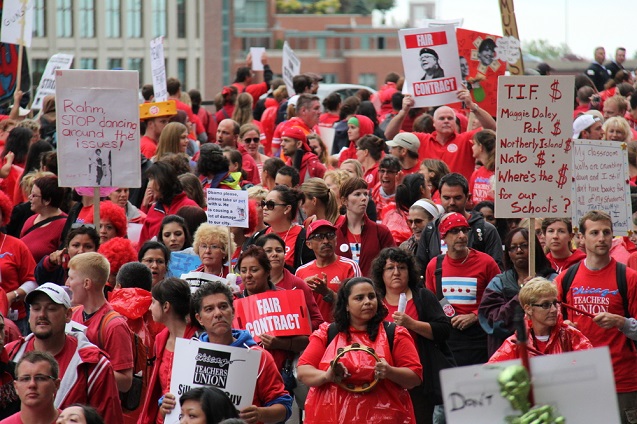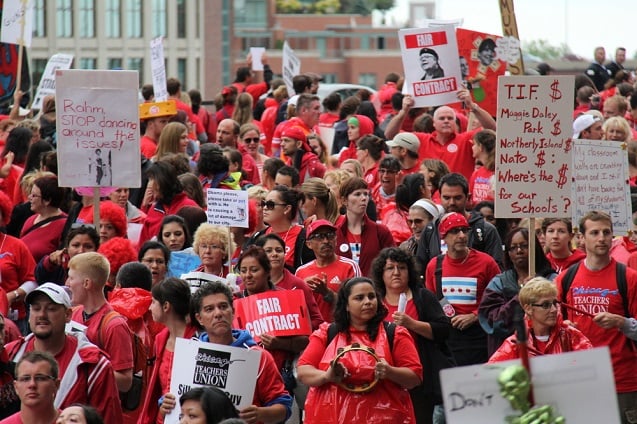
 via Shutterstock)” width=”637″ height=”424″ />Teachers on strike and protesting in downtown Chicago, September 13, 2012. (Photo via Shutterstock)
via Shutterstock)” width=”637″ height=”424″ />Teachers on strike and protesting in downtown Chicago, September 13, 2012. (Photo via Shutterstock)
On July 30, Reps. Keith Ellison (D-MN) and John Lewis (D-GA) introduced the “Employee Empowerment Act,” legislation that would make joining a union a legally protected civil right. The bill would bring union membership under Title VII of the Civil Rights Act – the same legislation that bars employment discrimination based on race, gender, religion, national origin and more.
While existing labor law already prohibits employers from disciplining or firing workers because of union activity, it does not have enough bite to deter employers. Bringing union membership under Title VII would add teeth to the law, allowing for punitive damages, lawyers’ fees, discovery and jury trials.
The idea, first promoted by Richard Kahlenberg and Moshe Marvit, is both to raise the legal stakes involved for employers tempted to flout the law, and to bestow upon labor rights the same legitimacy granted to civil rights. As Ellison explained, “If it’s a civil rights action, it’s vindicating your personal right, first of all to freedom of assembly and freedom of expression. . . . . And it’s your individual right to say what you want. Whether or not there’s ever even a vote, you shouldn’t be fired for expressing an intent to support union activity.”
Ellison and Lewis are unquestionably pro-labor, and Kahlenberg and Marvit’s proposal is clearly aimed at boosting labor’s sagging fortunes. But despite its intentions, this proposal could end up hurting unions more than it helps.
The problem is two-fold. First, as many have noted, including Jane McAlevey most recently, legal strategies in general put workers and their unions at a disadvantage. They displace the conflict between workers and employers from an organizing context where workers can play a leading role and build their own power, to a legal context where workers must rely on experts to fight for them. In this context, even victories occur after years of waiting, during which time the employer can maintain the status quo. In focusing on the legal process, Ellison’s and Lewis’ proposed legislation would not address these problems. Even worse, it risks entangling organizing even more deeply in a maze of legal technicalities.
Second, this proposal does not do enough to address the core problem with US labor law: its inability to prevent employers from interfering in workers’ decision to unionize. To be sure, the call to add punitive damages for employer violations is welcome. But the bill’s focus on enshrining labor rights as individual rights may reinforce the very dynamics that have allowed employers to turn labor law so far in their favor. As my own research comparing the formation and development of US and Canadian labor law shows, one of the key factors that has allowed US labor law to erode over time is precisely that it has attempted to enforce what are fundamentally collective labor rights within an individual rights framework.
Working within an individual rights framework, US courts and legislatures have preoccupied themselves with “striking a balance” between competing sets of rights. While it sounds fair, attempts to “balance” competing rights ignore the inherent power imbalance between labor and management. As a result, what might at a formal level seem “balanced” ends up tilted in management’s favor. So just as the 1935 National Labor Relations Act established the right to join a union, the 1947 Taft-Hartley Act and subsequent legal interpretations “balanced” that right with the right to refrain from joining a union. This paved the way for so-called “right to work” laws, which are now in place in 24 states, and are frequently identified as a key source of US labor’s weakness.
Similarly, courts have sought to “balance” workers’ right to engage in “concerted and protected activity” in favor of unions with a corresponding right of employers to convey their opinions of unions to workers under the so-called “employer free speech” doctrine. As Justice Learned Hand noted with regard to employer free speech, “[w]hat to an outsider will be no more than the vigorous presentation of a conviction, to an employee may be the manifestation of a determination which it is not safe to thwart.” Sure enough, Kate Bronfenbrenner and others have shown that employers have often used their “free speech” rights to engage in systematic campaigns of threats and intimidation explicitly designed to frustrate workers’ attempts to organize.
The focus on defending individual rights ignores that labor rights are fundamentally collective. They only become real when exercised as a group, and the benefits only accrue to groups. That’s why it’s called collective bargaining: The only way that workers can possibly counter the inherent power imbalance between labor and management is to band together as a group. It’s also why “right to work” laws are so pernicious: In the name of defending individual rights, they encourage free-riding, which undermines workers’ ability to exercise their collective labor rights.
In wrapping labor rights even more tightly within an individual rights framework, Ellison’s and Lewis’ proposed legislation risks playing into the same narrative of “balance” that has eroded US labor rights for more than 70 years. Of course, the real focus for labor revitalization needs to be on building independent organization in the workplace, something that unions themselves have ignored for far too long. But, to the extent legal reform strategies are on the table, the focus should be not on shoring up individual rights, but on creating a framework that protects workers’ ability to exercise their collective rights.
Key to this is legislation limiting employers’ ability to intervene in the unionization process. Just as employers are left alone to decide with which associations they wish to affiliate, so too should workers. Doctrines such as “employer free speech,” while fair-sounding, provide a green light for employers to trample workers’ labor rights with abandon. Redefining “employer free speech” as illegal coercion would do far more to defend labor rights than seeking even more protections from the courts that have failed US workers for decades.
Join us in defending the truth before it’s too late
The future of independent journalism is uncertain, and the consequences of losing it are too grave to ignore. To ensure Truthout remains safe, strong, and free, we need to raise $43,000 in the next 6 days. Every dollar raised goes directly toward the costs of producing news you can trust.
Please give what you can — because by supporting us with a tax-deductible donation, you’re not just preserving a source of news, you’re helping to safeguard what’s left of our democracy.